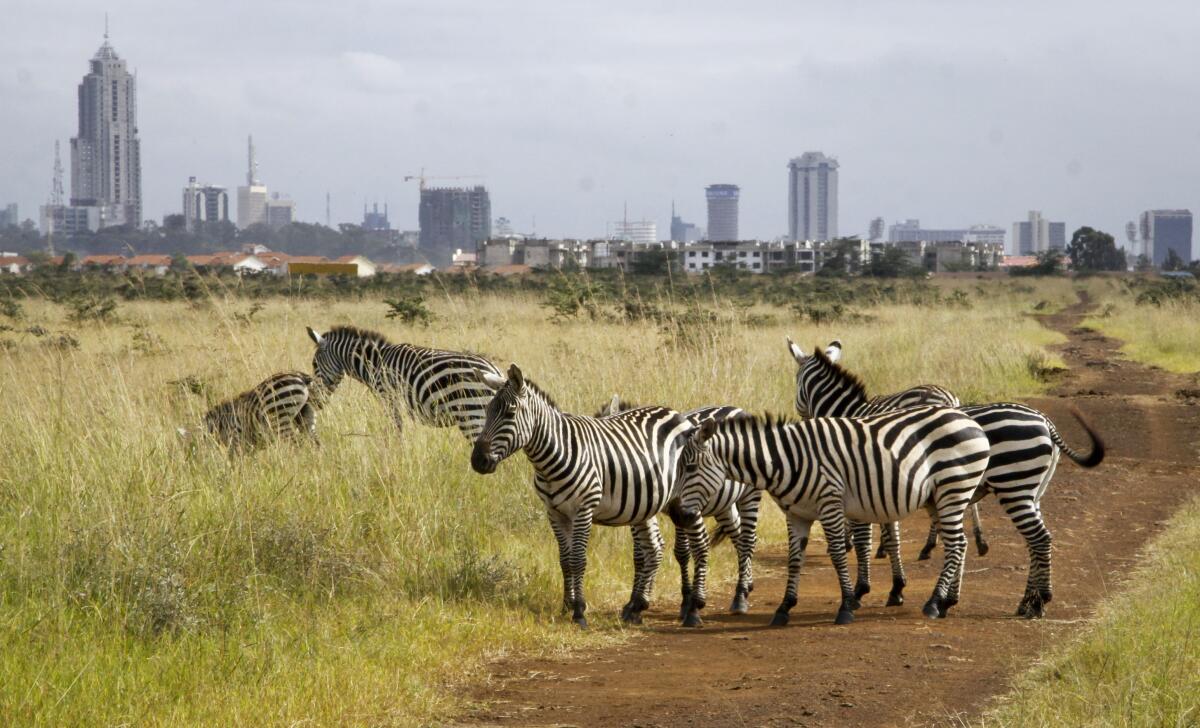Nature didn’t really bounce back in the pandemic. It showed how far we’ve pushed it

- Share via
In March and April 2020, when governments around the world issued stay-at-home orders to combat the exploding COVID-19 pandemic, the internet buzzed with thousands of reports of wild animals wandering deserted city streets. Images posted on social media showed flamingoes, boars, pumas, penguins, mountain goats and hordes of frantic macaques roving desolate neighborhoods that, just days earlier, had bustled with cars and pedestrians. News outlets on six continents declared that wildlife was reclaiming cities. A 2021 BBC documentary narrated by David Attenborough, “The Year Earth Changed,” hailed this outpouring of wildlife as a sign of nature’s resilience and as reason for hope in an era of human suffering and ecological devastation.
Two years later, research published on wildlife and the COVID-19 pandemic paints a more complicated picture. What at first seemed like a simple story — a human tragedy producing a boon for wildlife — now seems like an object lesson in the profound, complex and often unexpected connections between human health and the well-being of other species.
It’s not at all clear that crowdsourced observations from early in the pandemic reliably indicate a resurgence of wildlife. Many images from spring 2020, including an instantly iconic photo of dolphins frolicking in a crystal-clear Venice canal, turned out to be fakes. Even authentic records were subject to a sampling effect: People stuck at home, sitting on their porches or staring out of their windows, were more likely than usual to see and report wildlife. Changes in human behavior, not changes in the behaviors of other animals, were probably responsible for many wildlife sightings.
Yet some animals did react to new conditions created by the lockdowns. Their responses varied by species, ecosystem and location. In cities, populations of many wildlife species have been growing for decades. Most mammals found in urban areas — such as raccoons and coyotes — didn’t roam further than usual. But abrupt reductions in human activities may have allowed some creatures, including mountain lions, to shift their movements from night to day or wander more widely in search of food and mates.
The pandemic had several beneficial, if temporary, effects for wildlife. In March and April 2020, millions of cars, trucks, planes and boats went idle. Grounding thousands of aircraft probably saved legions of birds from becoming “snarge.” Decreases in shipping quieted the seas, offering a reprieve for sensitive marine mammals. Cleaner air, owing to reduced tailpipe emissions, may have allowed some insect populations to flourish during the northern hemisphere spring. With more food to eat, certain insect-eating birds, such as common swifts, appear to have laid larger numbers of eggs.
Fewer vehicles on the road meant fewer accidents, at least for a time. During those same two months, traffic in many U.S. states and European countries dropped by more than 70%. Researchers in Italy estimated that, during this period, roadkill among amphibians and reptiles declined by at least 90%. In the Polish city of Chelm, cars killed 50% fewer hedgehogs than is typical for these months. In California, reported collisions with pumas, which normally average two per week, dropped by 58%. The rate of wildlife collisions on American roads soon began to climb, however, and by the end of the year, roughly the same number of animals had died in 2020 as in 2019.
Tourism is a mixed blessing for wildlife; it supports local economies and funds conservation programs but strains ecosystems and aggravates climate change. During the first few months of the pandemic, global tourism evaporated. Empty beaches enabled nesting birds and sea turtles to go about their business in relative peace. Yet the tourism collapse had several negative consequences. From Bangladesh to Morocco to Zimbabwe, conservationists reported increases in poaching and wildlife trafficking, along with cutbacks in research, education, firefighting and law enforcement.
Some commerce boomed during the pandemic, taking a greater toll than usual. Strong demand for wood and paper products has fueled deforestation in countries as diverse as Brazil, Cambodia, Nepal, Madagascar and Romania.
COVID-19 also has more direct connections with wildlife. The SARS-CoV-2 virus most likely originated in horseshoe bats from Southeast Asia before “spilling over,” perhaps through an intermediate host, to infect people. Since then, the virus has circulated widely in several additional species, from captive mink in Denmark to white-tailed deer in Ohio, raising concerns that a new variant may “spill back” into humans.
Commentators often refer to virus transmissions between species in the wild as “natural,” but this is a misleading term. The biological processes that enable spillovers and spillbacks may be natural, but the ecological contexts in which they occur are increasingly unnatural. Habitat destruction and biodiversity loss — which simplify ecosystems, stir up germs and expose people to more potential pathogens — are helping usher in a new age of emerging diseases. After a brief pause, both have accelerated.
It’s true that the pandemic is a medical, economic and political crisis. It is also an ecological crisis and a crisis in the relations between humans and other species. To reduce the risk of future pandemics, for both people and wildlife, governments and other institutions should embrace ambitious conservation efforts such as the 30 by 30 initiative, aiming to preserve 30% of U.S. land by 2030.
They should also invest more heavily in a multifaceted “one health” approach, which recognizes that human well-being is tied to that of myriad other species. One lesson to learn from the pandemic is that we are all, in the end, animals.
Peter S. Alagona is a professor of environmental studies at UC Santa Barbara, and the author of “The Accidental Ecosystem: People and Wildlife in American Cities.”
More to Read
A cure for the common opinion
Get thought-provoking perspectives with our weekly newsletter.
You may occasionally receive promotional content from the Los Angeles Times.









